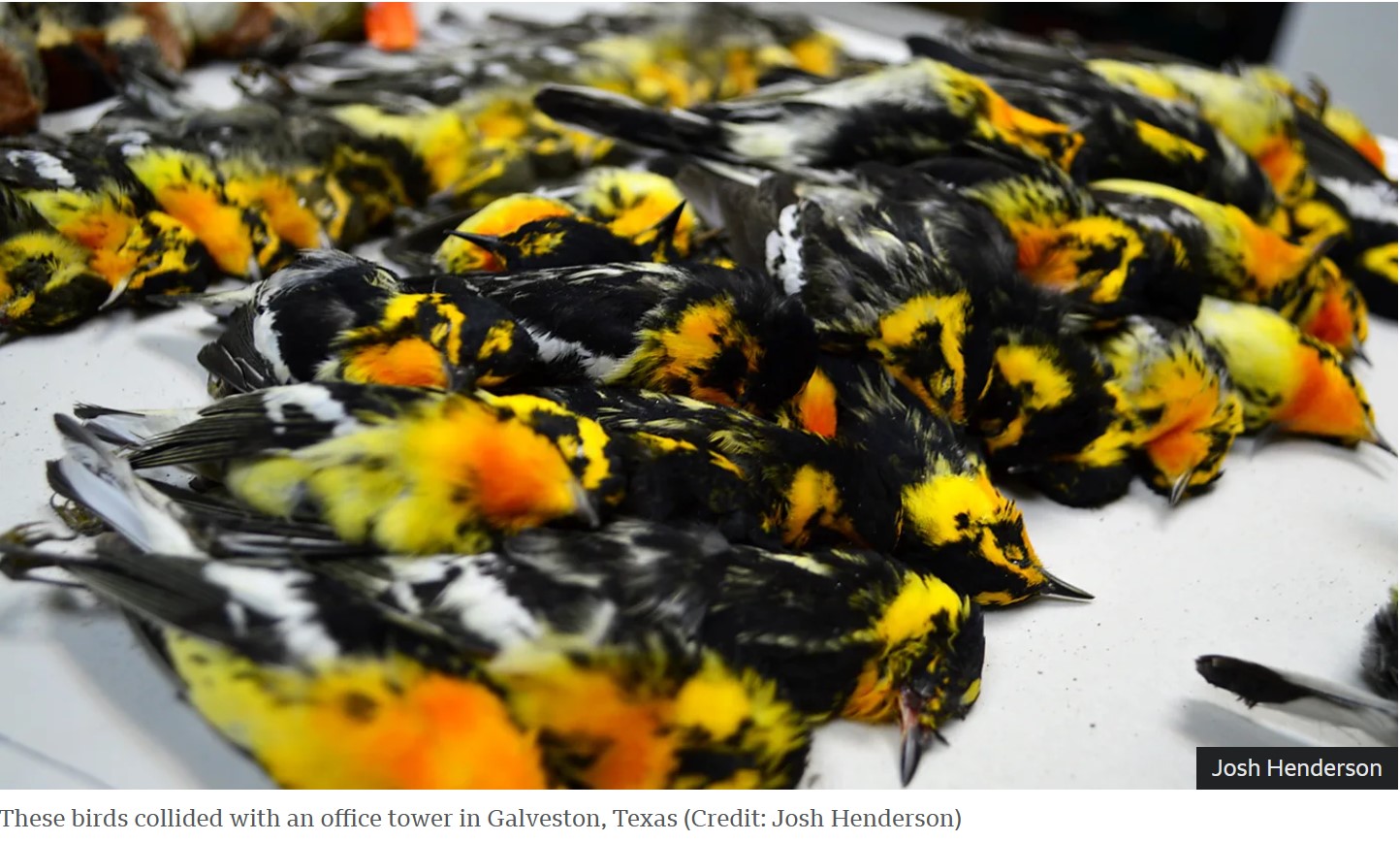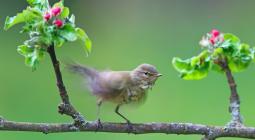Texas' skyscrapers are going dark to keep billions of birds safe

About two billion birds fly through Texas in the spring – and lit-up buildings pose a deadly risk. Turning out the lights at night could save countless fatal collisions.
It was a foggy Thursday morning when animal services supervisor Josh Henderson received news of a mass mortality. On May 4, 2017, 395 migratory birds died after smashing into one office tower in Galveston, Texas. Henderson rushed to the scene to witness the gruesome spectrum of feathers from yellow and orange to blue and grey of the lifeless small-featured bodies.
"It was awe-inspiring and tragic," says Henderson, who is now the executive director of the Humane Society in Galveston.
Most of them were warblers: small, bright, colourful birds that are particularly abundant in Texas. They had been on their homecoming spring migration, an epic journey that takes them from wintering sites as far south as Mexico to nesting sites as far north as Canada, according to the National Audubon Society, a US-based bird conservation group.
For birds, Texas is a major flyover state: approximately two billion birds, or one in three birds migrating through the US, fly through the Lone Star State in the spring. It is snugly situated at the convergence of two major migratory flyways – the broad north-south routes that many different bird species all use to migrate. Both the Central Americas Flyway, which stretches from the Canadian Arctic to the southern tip of Argentina, and the waterway-rich Mississippi Flyway, beloved by migratory waterbirds, pass through Texas.
Along the route, hazards abound – including bright city lights. Though the Galveston collision was a particularly dramatic example, birds hitting buildings is a common phenomenon. Every year, between 365 million and one billion birds are thought to be killed in building collisions in the US. The risk increases when they migrate and pass through cities in large numbers.
More than half of those fatal crashes are actually with low-rise buildings, such as people's homes. Birds may collide with them in small numbers per building, but it adds up, as houses are so widespread. However, as the Galveston case and mass bird crashes in other US cities show, big lit-up buildings such as skyscrapers, convention centres and office blocks can pose a disproportionate threat, killing hundreds of birds at once, because of each building's sheer scale. In October 2023, nearly 1,000 birds died in a single night during their autumn migration from striking a lakeside convention centre in Chicago.
The scene of the mass collision in Galveston was a 23-floor skyscraper called One Moody Plaza. The tallest building in downtown Galveston used four corner spotlights pointing straight up in the sky and a glowing green halo of LED lights around the top of the tower.
"You could be seven miles offshore in a boat and the first thing you'd see was the green light," Henderson tells BBC Future Planet.
Not unlike the title character in F. Scott Fitzgerald's The Great Gatsby, the birds appeared to be fatally attracted to this alluring green light.
The influence of artificial light in urban spaces is a well-known phenomenon among birds, but is still not fully understood. Birds tend to migrate by night, and use the stars to navigate. By day, they use the position of the Sun to orient themselves. During nocturnal migration, they are often seen gathering around or crashing into lit-up windows and structures, or gathering around beams of projected life. The artificial glow of cities also appears to attract them for stopovers. One explanation is that they may generally fly towards light sources, but also, that the artificial light confuses, traps and disorients them.
"Every tragedy is an opportunity to educate," says Henderson. He sorted and identified the bodies of the deceased birds, which were then entered into the natural history collections at Texas A&M University and Louisiana State University. Henderson's team was able to save and rehabilitate three birds.

"It was determined that the building's illumination may have played a part in attracting and disrupting the birds during the storm," says Scott Campbell, the senior vice president of corporate communications at American National. "We did not take the incident lightly."
The accident prompted Houston Audubon, a bird conservation organisation, and American National Insurance Company, which occupies the building, to take action and jointly develop a science-based response.
At the time, several existing, successful campaigns in the US and Canada encouraged building owners, developers and businesses to switch off non-essential lighting to help travelling birds. One was Toronto's Fatal Light Awareness Programme (FLAP). The National Audubon Society also had Lights Out campaigns in several cities and states, which encouraged businesses and individuals to switch off unnecessary outdoor lights at night.
American National Insurance implemented – and still follows – a policy of turning off their exterior building spotlights and interior lights at night during the spring and fall migratory seasons, says Campbell. After the collision event, American National Insurance Company partnered with the Houston Audubon Society to hold workshops in Galveston to educate the community on migratory bird patterns in the Gulf Coast portion of Texas.
The first Lights Out for Birds programme was formed soon after in the Houston area, which has now expanded into the statewide "Lights Out, Texas!" effort with Audubon Texas.
The 2017 mass bird crash was the only collision event at the One Moody building, Campbell added.
"Texas is a place where we want to make sure that passage is as easy and safe as possible" - Andrew Farnsworth
Around the same time as the Galveston bird crash, the Cornell Lab of Ornithology developed a way to forecast bird migration during specific times and locations, using radar. The resulting BirdCast migration forecast maps are freely accessible. Their live migration map allows anyone to check how many birds are migrating now, and where, as well as how many are predicted to pass in the near future. For one night in October, they recorded a "billion bird night", with that number or more birds passing in a single night.
In 2020, Cornell, Houston Audubon and a range of other organisations joined forces to start the "Lights Out, Texas!" campaign, which encourages building owners, developers and businesses to switch off non-essential lighting from 11pm to 6am each night during spring and autumn migration. Timed for around March-June (spring migration) and August-November (autumn migration), the campaign aims to help create a safe passage for nocturnally migrating birds. Since then, Lights Out Texas has taken hold in every major city in Texas. The state is considered an especially important place for the campaign given its position as a mass bird migration hotspot.
"Texas is a place where we want to make sure that passage is as easy and safe as possible," says Andrew Farnsworth, a migration ecologist at the Cornell Lab of Ornithology. The community of birds that migrate through Texas are smaller songbirds, he says, including a diversity of warblers and sparrows. In his view, those are the birds that benefit most from the Lights Out effort in Texas because that state is on their route.
Around 24 communities in Texas have pledged to follow the Lights Out recommendations.
Early data collection suggests that Lights Out is effective, says Chloe Saucedo Crumley, the public affairs and engagement manager at Audubon Texas. After tracking the bird crashes at Chicago's towering McCormick Place over 20 years, researchers found a 60% decrease in bird mortality when lights are turned off.
In Texas, given the limited data and uncontrollable factors of studying animals that travel thousands of kilometers, "it's hard to assign causation and correlation already" says Crumley. In the meantime, scattered volunteer birdwatchers monitor how migrating birds interact with asphalt jungles in Texan cities. More than 3,600 individual birds representing 127 species have been identified by volunteers as colliding with buildings since 2020. Researchers at the nonprofit Defenders of Wildlife have generated a heat map that identifies which buildings have had the most collisions.
Chicago, Houston, Dallas, New York City and Atlanta are the cities where the threat to migrating birds is greatest, in terms of light pollution, Farnsworth says. All these cities maintain a Lights Out campaign, according to Audobon's records.
Protecting birds is vital both for their own sake and for the wider ecosystem, Farnsworth says. "The whole canary-in-the-coalmine euphemism is true. Birds are good bioindicators and proxies for ecosystem health," he says. "Plus, birds look really cool, sound really cool and have really interesting behaviours."
However, protecting species that move presents special challenges for researchers and conservationists, compared to protecting a resident population, Farnsworth points out. Migrating birds can travel thousands of kilometres, crossing and stopping in many different habitats, traversing borders, and flying through cities – which are continuing to grow around the world, with urban sprawl replacing and fragmenting birds' habitats.
Farnsworth suggests that given this complex picture, there is no single solution to helping migrating birds. Instead, in his view, spreading awareness, empathy and efficient enforcement are all crucial in keeping them safe and avoiding collisions. "We need to keep our connection to nature through our eyes, ears, nose, whatever – and use senses to experience the core of all this research and observation."









